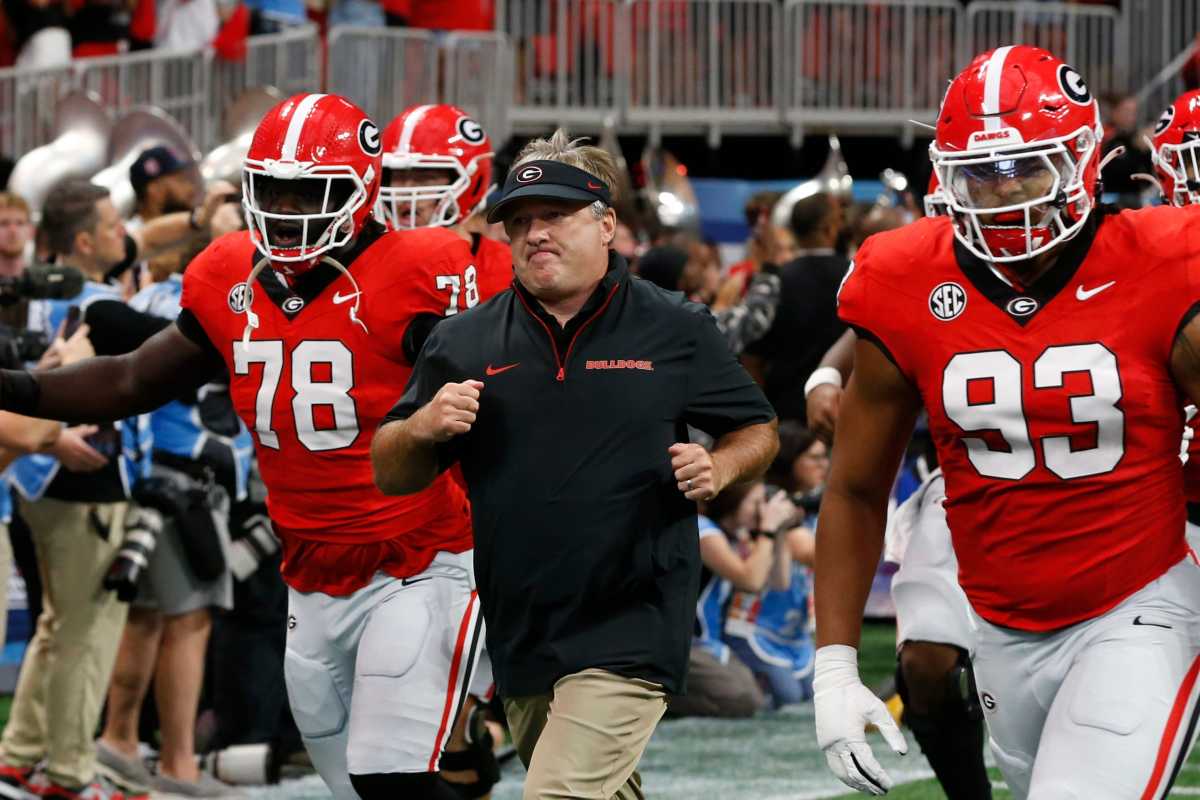Hook’d in the Peach State: How Texas Snatched Another Blue-Chip Georgian—and What That Warning Shot Means for Kirby Smart’s 2026 Recruiting War
There was a time—not long ago, really—when losing an in‑state blue‑chip to an out‑of‑region power sent Georgia fans into a brief grumble cycle, then disappeared under the tidal force of Kirby Smart’s top‑three national classes. Miss one, sign five. Shrug, reload, win rings. But the 2026 cycle is writing a livelier script, and the newest plot twist is a bright burnt‑orange flare over SEC territory: Texas just pulled another high‑end Georgia native out of the Peach State talent orchard, and while the Bulldogs remain firmly entrenched as an elite national recruiting power, this one hits different because it’s part of a pattern—one that intersects NIL maturity, positional runway salesmanship, and the expanding gravitational pull of a Texas program that no longer needs the Big 12 qualifier when entering living rooms. Combine that with the Longhorns’ transition into the SEC ecosystem and you get a rivalry‑within‑a‑rivalry battlefront stretching 900 miles east, where every Metro Atlanta offer the Horns push feels less like a longshot and more like a live round. Georgia football’s 2026 recruiting update is suddenly less a ledger of silent commits and more a live‑fire map of contested ground.
Let’s zoom in on the flip itself—or the steal, depending on which fan base is tweeting. The player at the center of the latest tug‑of‑war is a Georgia native coveted for trench violence and scheme versatility, the kind of prospect the Bulldogs typically lock down by a second visit. Measurables? Prototype length, verified multi‑sport athletic profile, and the frame to carry Sunday weight without losing first‑step juice. In other words: the exact body type Georgia has built its defensive identity around during the Smart era. That Texas convinced him to jump—or more accurately, to project himself into Austin’s future—tells us something about how the Longhorns are packaging opportunity. They’re not just selling “come play in the SEC now that we’re in it”; they’re selling be the Georgian who comes here and beats Georgia on the biggest stage. That motivational inversion has teeth. Recruits respond to legacy pitches, especially when they’re framed as bets on self, not surrender to distance.
Texas has always recruited nationally in name, but the hit rate waxed and waned depending on in‑state cycles and coaching stability. The current staff has stabilized the national board by segmenting talent regions with role specificity: West Coast skill flair, in‑state linemen volume, and now—critically—Southeast defensive speed and interior disruptors who have spent their high school lives facing spread tempo one Friday, heavyweight gap another. Georgia high school football, particularly in the greater Atlanta corridor and the southern growth belts, produces linemen who have seen everything; that versatility travels. When Texas staffers sit in living rooms and roll SEC film, then overlay it with a schematic cutup of how they plan to deploy length and leverage in their front, the sell gets real. Add SEC membership and a path to play in the same conference as home‑state friends who signed with Georgia, Alabama, or Tennessee, and you turn an out‑of‑state offer into a reunion tour.
For Georgia, the headline sting is more about optics than roster crisis—but optics matter in recruiting because perception drives peer decisions. The Bulldogs have depth charts layered three classes thick at most defensive positions, and internal evaluation boards always include national contingency targets. Still, part of Kirby Smart’s dominance has been a psychological perimeter around the state’s top 15–20 prospects. When that perimeter gets breached twice in short order—by Texas, of all brands, a program on the rise in the same league you intend to control—the social proof equation shifts. Younger recruits watch older kids leave; high school coaches take new phone calls; seven‑on‑seven handlers expand the travel map. One departure is a curiosity. Two becomes talking‑point currency. Three triggers copycat confidence. That’s why Georgia staffers attack these moments aggressively: quick follow‑up visits, camp invites, renewed emphasis on “in‑state legacy” messaging, and film calls that re‑center development narratives.
Development remains Georgia’s trump card, the long‑arc argument that has survived every NIL head fake and flash commitment fad. The Bulldogs can point to draft boards dotted with names who redshirted, waited, rotated, then cashed first‑round checks. That evidence carries weight with families measuring three‑year trajectories, not three‑month hype cycles. Texas knows it and has countered not by dismissing development but by speeding its own up—early enrollee acceleration tracks, multi‑angle film analytics for technique work, and an open embrace of the portal to keep competition hot without hollowing morale. Recruits now ask, directly, “Who have you put in the league from my body type?” Texas has better answers today than five years ago, and as those examples compound, the developmental gap shrinks perceptually even if Georgia’s sample size remains deeper.
NIL is the wild‑card accelerator. The 2026 class is the first full post‑realignment cycle where recruits grew up watching NIL normalized, not debated. That means they and their families evaluate financial ecosystems with more sophistication: Is there a baseline floor for all scholarship players? Are performance escalators tied to branding deliverables or snap counts? How transparent are payout timelines? States differ in how tightly collectives integrate with school infrastructure; some boosters prefer splash, others sustainability. Texas’ donor base is historically deep and theatrically competitive; when aligned with institutional messaging, it can outscale most markets. Georgia’s NIL universe has matured quickly but deliberately, leaning toward locker‑room balance and retention. If a prospect prioritizes headline guarantees, the Longhorns can lean in; if he values culture stability, Georgia’s pitch resonates. Individual decisions hinge on which axis the family values most.
The geography conversation, once a huge differentiator, has softened in the portal age. Recruits no longer feel trapped by early distance decisions because the one‑time transfer rule (subject to evolving NCAA/legislative frameworks) lowered switching friction. That freedom emboldens players to take bigger swings out of state, knowing they can course‑correct. Texas has used that psychological shift masterfully, positioning itself as a program confident enough to sign nationally and keep you happy—but secure enough in its culture to say, “If it doesn’t fit, we’ll help you find your path.” Counterintuitively, that openness can reduce transfers because recruits sense trust. For Georgia, the sell remains: stay close, play in front of family, join a proven championship apparatus, and train at the highest level of defensive detail in the sport. Both are compelling; the 2026 cycle is simply the first where the Longhorn message has SEC proof behind it.
Let’s talk roster math and why this particular Georgia native mattered in Austin war rooms. Texas views the trenches as the final conversion layer between “explosive offense contender” and “multi‑year playoff resident.” SEC life means November attrition in the A‑gaps; if you don’t rotate 8–10 linemen who can hold point and disrupt, your linebackers get erased. Sizing up Alabama, LSU, and yes, Georgia tape over the last five years convinced the Longhorn staff that Southeastern defensive line DNA—length + leverage + lateral pursuit training—had to be imported in volume, not cameo. Landing a high‑ceiling Georgian fits a macro build, not a trophy chase. Stack three such bodies across two cycles and Texas stops scheming parity and starts owning it.
Where does this leave Georgia’s 2026 board? Still loaded, still nationally lethal, but with renewed urgency on in‑state touches. Expect more satellite camps in underserved corners of the state, increased high school coach clinics, and earlier committable offers to trench prospects who might otherwise slow play. Georgia has traditionally been comfortable letting evaluations mature deep into junior film because it could close late; the Texas incursion may accelerate some timelines. You’ll also see the Bulldogs flex national reach to backfill—California, DMV, Midwest hybrid ends—reminding everyone that Georgia doesn’t need any single in‑state player to stay elite. That posture can both calm the fan base and challenge undecided recruits: spots are limited; decide early or risk getting recruited over. Scarcity sells.
Fan chatter predictably splits into panic and posture. The panic camp catastrophizes: “If we can’t wall off Atlanta, the dynasty’s over.” The posture camp shrugs: “Let ’em have one; we’ll take five from elsewhere and meet in the playoff.” Reality lives between. Georgia will lose in‑state battles occasionally; it will also win national raids that devastate other programs’ message boards. What matters is aggregate class composition across needs, not perfect retention. Still, the emotional charge around “Texas steals another Georgia native” is recruiting currency in itself—future prospects see passion, see demand, see how much their decisions matter. Programs leverage that attention in quiet DMs: “You saw what the fan base said when we lost one. Imagine how they’ll celebrate you if you stay home.” Every narrative becomes a pitch.
So mark the 2026 cycle as an inflection year in the Georgia‑Texas talent lane. The Longhorns aren’t dabbling; they’re planting flags. The Bulldogs aren’t fading; they’re recalibrating their perimeter alarms. Somewhere in a Georgia weight room, a graduate assistant just clipped the headline and taped it to a recruiting board. Somewhere in an Austin war room, staffers are mapping the next Peach State campus visit window. And somewhere in a high school hallway outside Atlanta, a rising junior defensive lineman is scrolling through edits from both staffs, calculating where he fits, how quickly he’ll play, what the NIL baseline looks like, and which place he trusts to turn Friday flashes into Sunday contracts.
Recruiting is never static, especially when conference maps redraw and money meets ambition. Texas taking another Georgia native is both a data point and a message: borders are myths, development travels, and the SEC’s newest old power intends to shop in every aisle. Georgia’s answer will not be panic; it will be precision—the same data‑driven evaluation machine that built a national power will now tighten its local net and widen its national drag simultaneously. The 2026 class will show whether the Longhorn incursion is headline noise or structural shift. Until signatures turn ink in December 2025, every visit, call, and camp rep is contested airspace. Strap in; the trench war between Athens and Austin just opened a fresh front, and the next blue‑chip Georgian to pick a hat will be doing more than choosing colors—he’ll be drawing the next line in college football’s most intriguing cross‑state, cross‑conference recruiting fight.



